Enter the Rabbit Hole
Purpose: Multisensory Research Facility
Total Building Square Footage: 4,165 sq ft
Location: Undisclosed
Year: 2021
Role: Designer and Author
Self-Employed
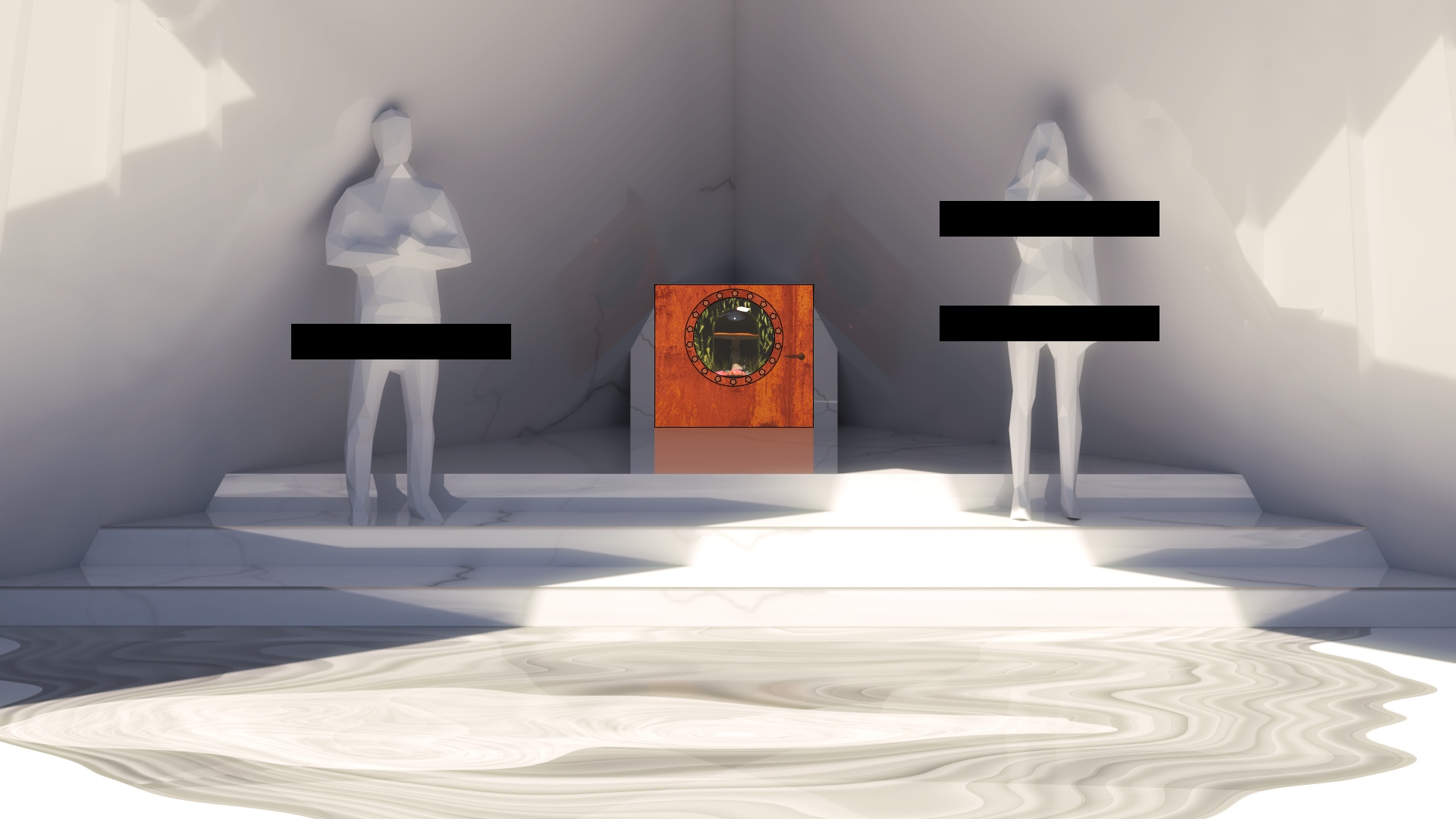
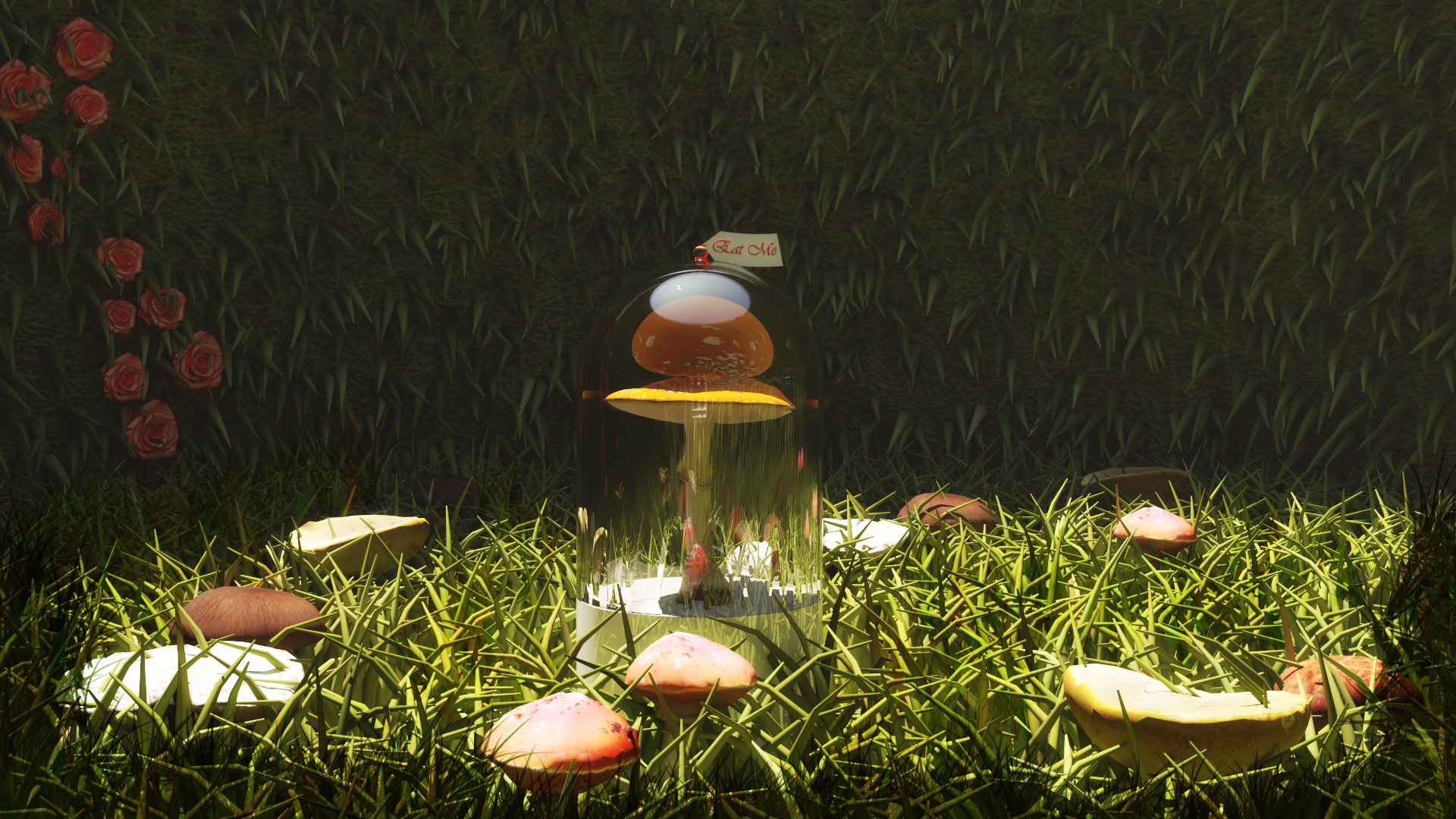
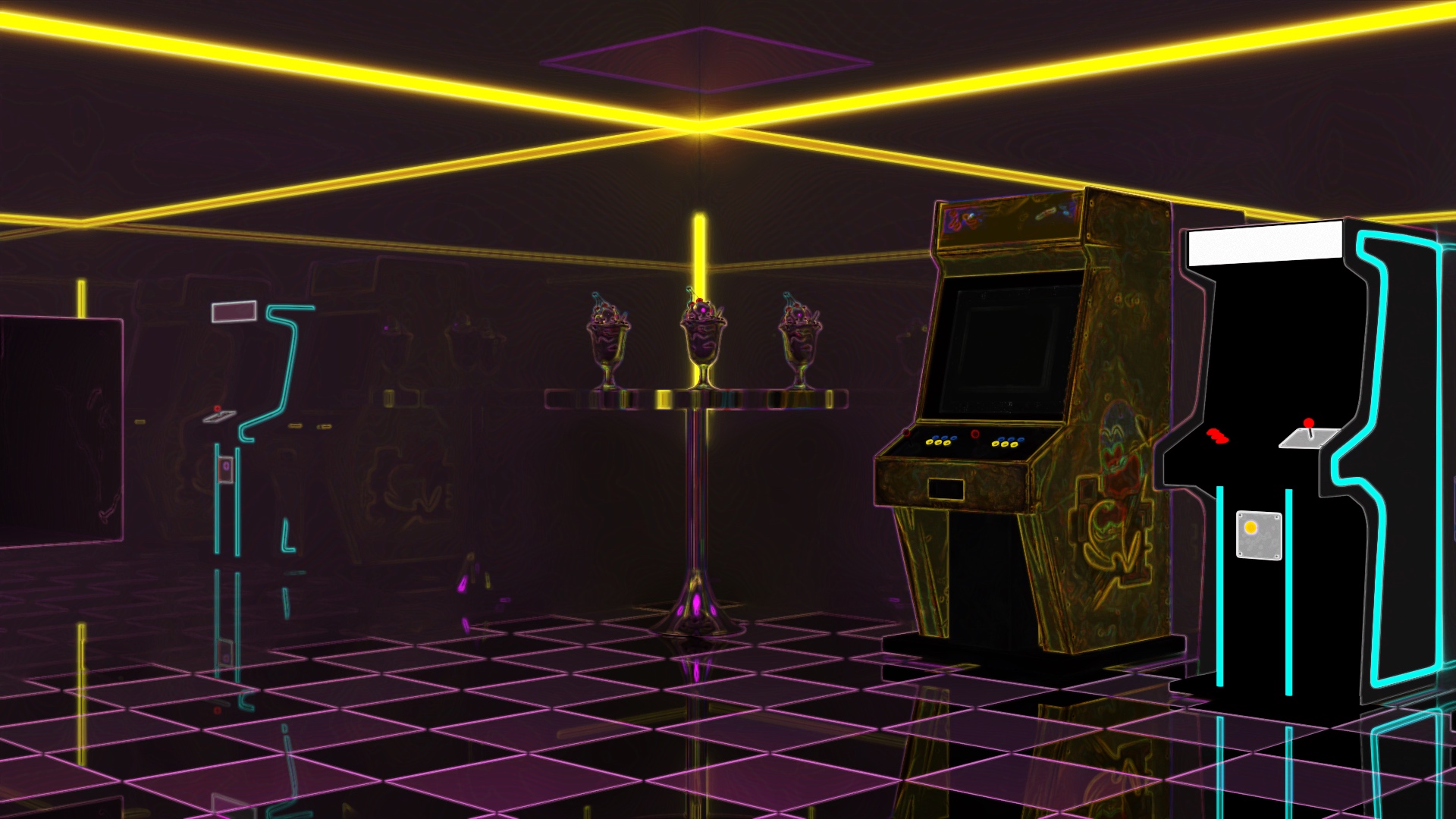
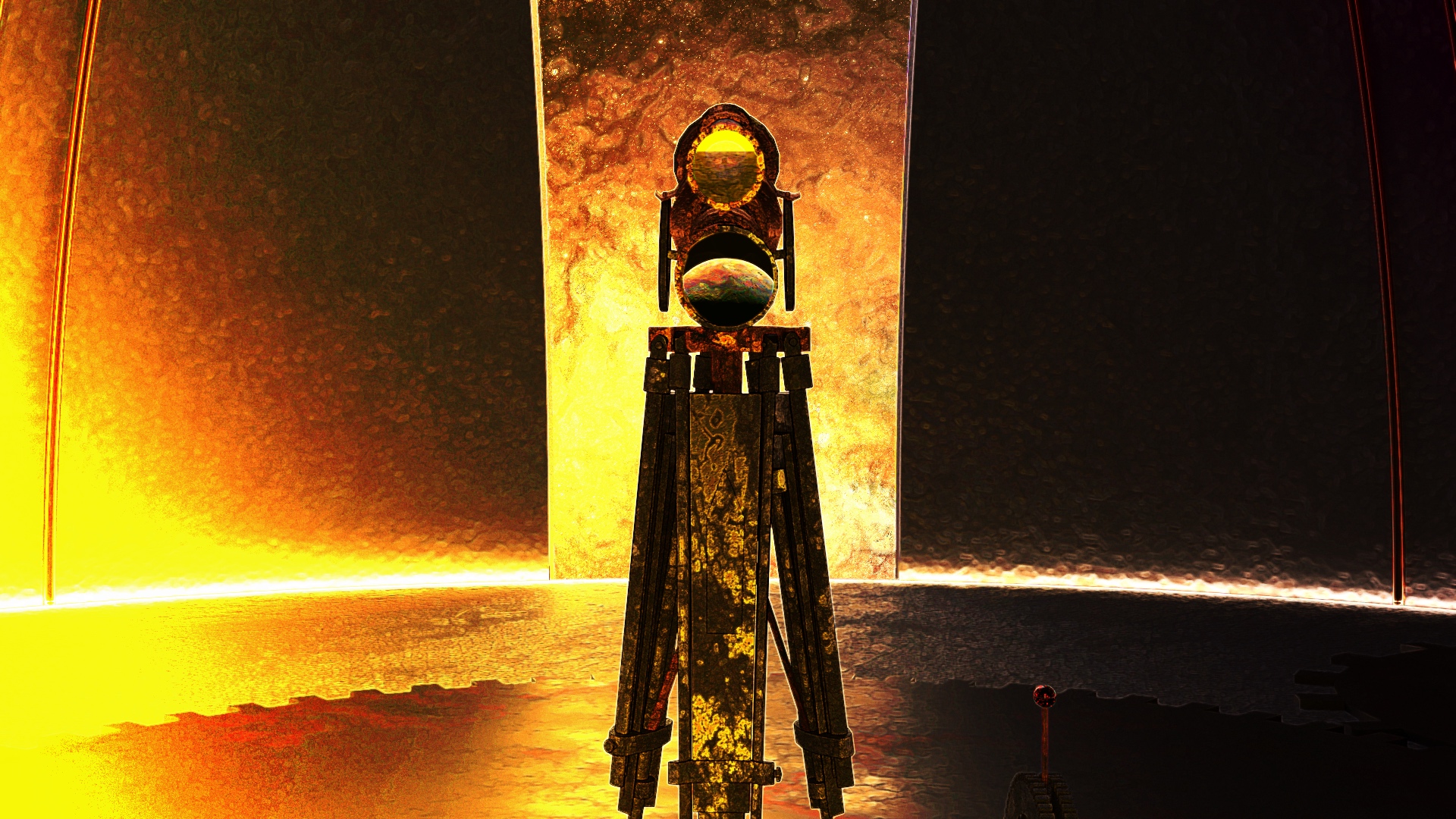
Above, Clockwise A montage of the four rooms that make up the test facility: "Rococo Opulence," "Forest Shaman," "The Observatory," and "Neon Nostalgia".
Room I (Image 9)- Rococo Opulence: A viewing window opening on the tunnel entrance door intrigues test subjects and encourages them to continue exploring.
Room II (Image 10) - Forest Shaman: The “Eat Me” note attached to the glass bell jar enclosing the psychedelic mushroom.
Room III (Image 11) - Neon Nostalgia: Test subjects can use the arcade machines and the jukebox while experiencing the effects of the psychedelic mushroom. Subjects can enjoy a sundae as well. The coolness of this room provides relief from the prior room.
Room IV (Image 12) - The Observatory: Test subjects can use the lever beside the telescope to open the observatory hatch. Subjects can use the dials on the telescope to focus on the moon and clusters of stars. What subjects observe through the telescope may be affected by the psychedelic mushroom. The warmness of this room contrasts with the coolness of the prior room.
The World Health Organization (WHO) defines “health” as “a state of complete physical, mental and social well-being and not merely the absence of disease or infirmity”.[1] WHO’s definition gets to the nub of what a profound architectural experience entails. It accounts for dynamic psychological and physiological states and allows humans to fulfill mid-tier and higher-level needs (Image 1).[2] A riveting architectural space is comparable to the Goldilocks Zone, where a planet’s ecosystem allows life to flourish.[3] In a time when city planners are looking for the next 'panacea of a building' to breathe life back into their communities, what separates an ordinary building from that of an awe-inspiring masterwork?
Sensory qualities of a space, in conjunction with proportion, have the potential to heighten the overall human experience when occupying a work of architecture.[4] An ordinary building satisfies basic needs, if even, and stops there. Likewise, a self-aggrandizing and eye-catching building design can fail to incorporate other sensory qualities and meet human needs.[5] In short, the sensory shortcomings belie the building’s dazzling façade. Hence, refinement of the human needs models by Abraham Maslow and Manfred Max-Neef is recommended; to examine if there is a correlation between human needs and sensory experiences (Images 1 and 2). Both models explore human homeostasis, achievement, and self-discovery and could inform the senses implemented in future architectural spaces.[6] With a multisensory focus, aspiring architects might accelerate a rise in their credibility, with building designs that fulfill complex human needs. Multisensory buildings should provide the stage for maximizing human experience, and in doing so, become timeless. Yet, architects whose buildings engage vision, coupled with another sense, are an anomaly.[7] Enter like Tom Kundig and Frank Lloyd Wright.
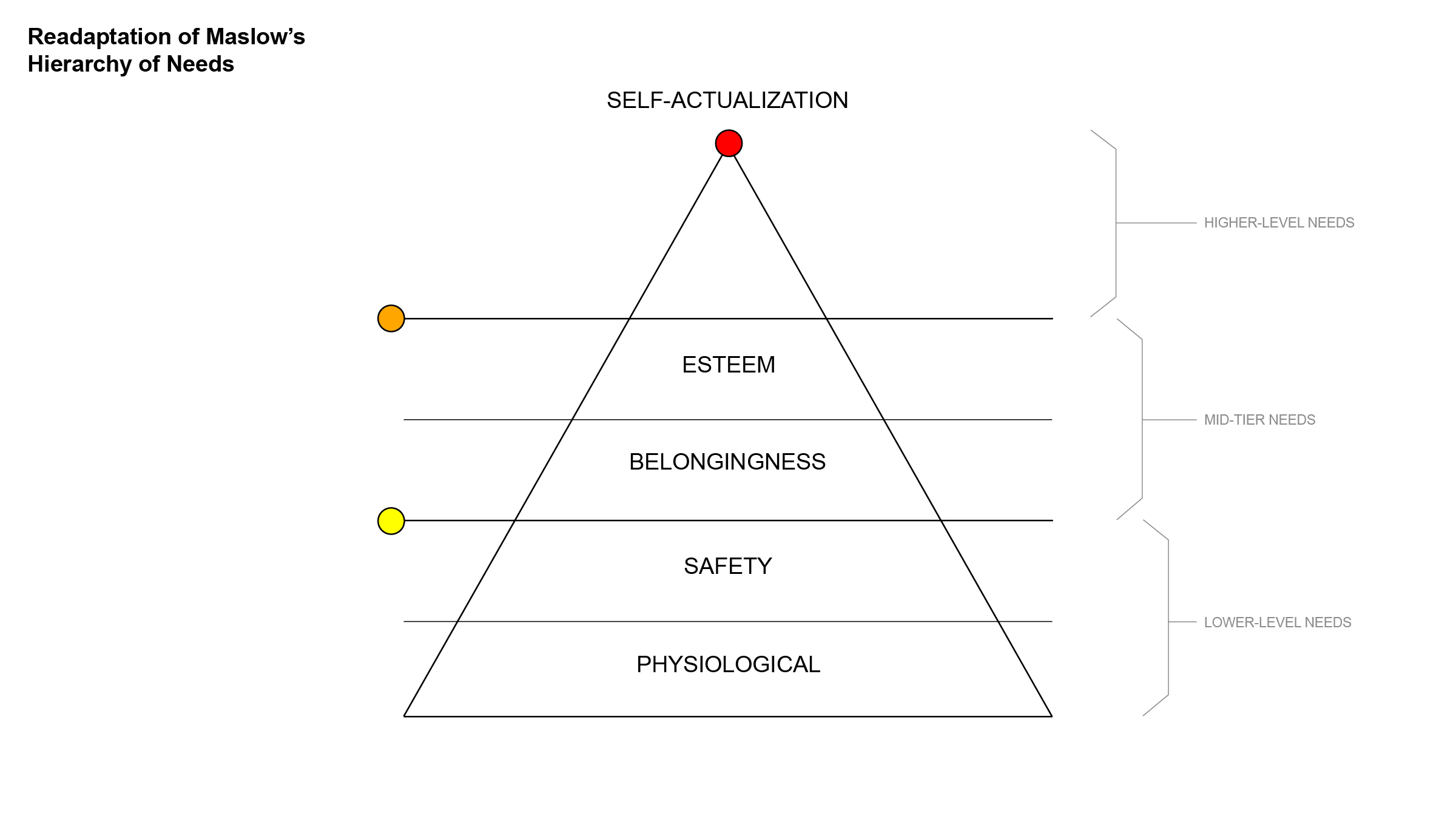
Above, Image 1
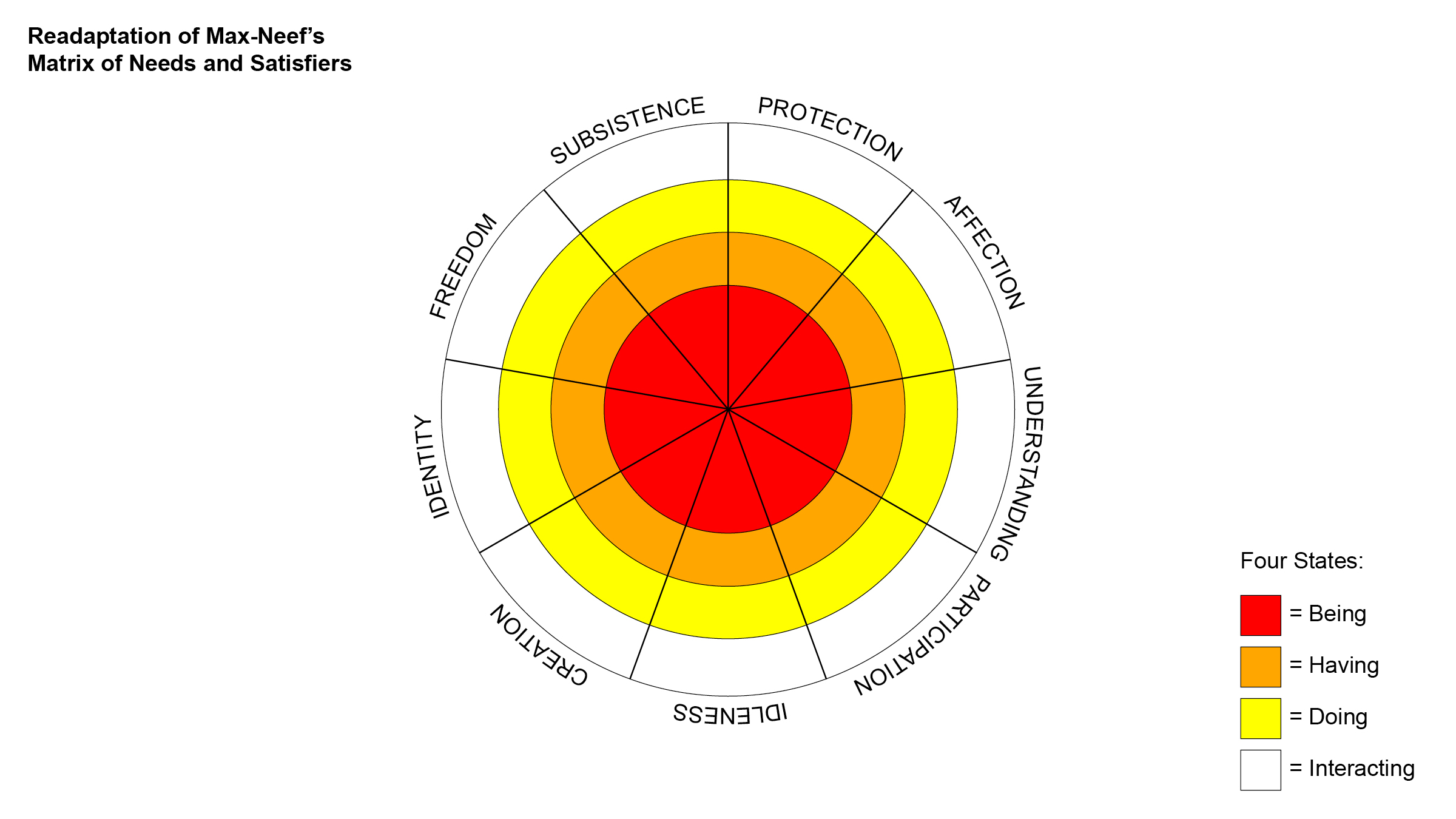
Above, Image 2
Kundig’s “gizmos” encourage human touch and Wright’s use of ‘compression and expansion’ affects position perception or proprioception.[8] Unknowingly or not, Kundig and Wright leverage these sensory qualities to stir feelings of ecstasy in some inhabitants. At the writing of this essay, there is no prescribed approach to designing emotionally resonate spaces. Often it is only through years of design experience, that ordinary architects can hone their spatial and sensory discernment—and blossom into respected architects.[9] The architects who consistently design profound buildings may have subconsciously polished their intuition and methodologies.[10] One can speculate that architect’s instincts manifest in their architectural style and the feelings elicited by their buildings. The works of the aforementioned architects have tapped into a couple of sensory qualities, but seldom unite all of them. Architects can make awe-inspiring architectural experiences less random through a careful orchestration of multisensory journeys.[11]
Before implementing multisensory, spatial processions in buildings, observational research is essential. Architect’s need to gauge the multisensory effects on a person’s unique psychology, physiology, subjectivity, and architectural experience. The four, sequenced laboratory spaces and three linkage Tunnel-Funnels accomplish this task (Image 3). Samin Nosrat’s book Salt, Fat, Acid, Heat: Mastering the Elements of Good Cooking describes four eponymous cooking qualities that lead to a transporting culinary experience.[12] Similarly, each room in this laboratory has a complementary milieu that is intended to conjure feelings of bliss.
Besides the seven senses, the three principles involved in this spatial sequence are: (1) the “contrast effect,” (2) sensory scarcity, and (3) the effects of psilocybin mushrooms on the senses (Image 4).[13] Firstly, each space’s sensory qualities are juxtaposed with the prior room’s qualities, so that each space mutually enhances the next.[14] Secondly, by withholding necessities, and giving users glimpses of “affordances,” people are drawn further into the depths of the spatial sequence, in a process of sensory scarcity.[15] James J. Gibson’s “perception-action” process; Max-Neef’s “Deprivation” discussion; Michael Arbib and Donald House’s “Vector Field Model”; and Rachel and Stephen Kaplan’s “Preference Matrix” have all informed the abovementioned concept of sensory scarcity (Images 5, 6, 7, and 8).[16] Finally, the mind-altering mushrooms may exaggerate sensory input and trigger synesthesia.[17]
Time to enter the rabbit hole. Test subjects begin in a cold, marble-covered room, and are in the company of two, nude chanters who pause to signal to the tunnel entrance (Image 9). Subjects can interact with the performers but are compelled to crawl through the humid tunnel to the next room, with its comforting light, warmth, and flora (Image 10). After following the instructions and ingesting the psychedelic mushroom, the world begins to spin. In the third room neon lights, arcade machines, and a glowing cube are obscured by a sweet-scented mist, creating an air of mystery (Image 11). Having eaten the sundae in the third room, the subject crawls through another tunnel and pushes the cube lightly—revealing the fourth room. The fourth room contains an operable telescope focused on the night sky (Image 12). Inside the spherical shell of The Observatory pure silence pervades. Overhead is a congealing mass of stars.
Disclaimer: The author of this essay does not condone the recreational use of psilocybin mushrooms or similar psychedelics.
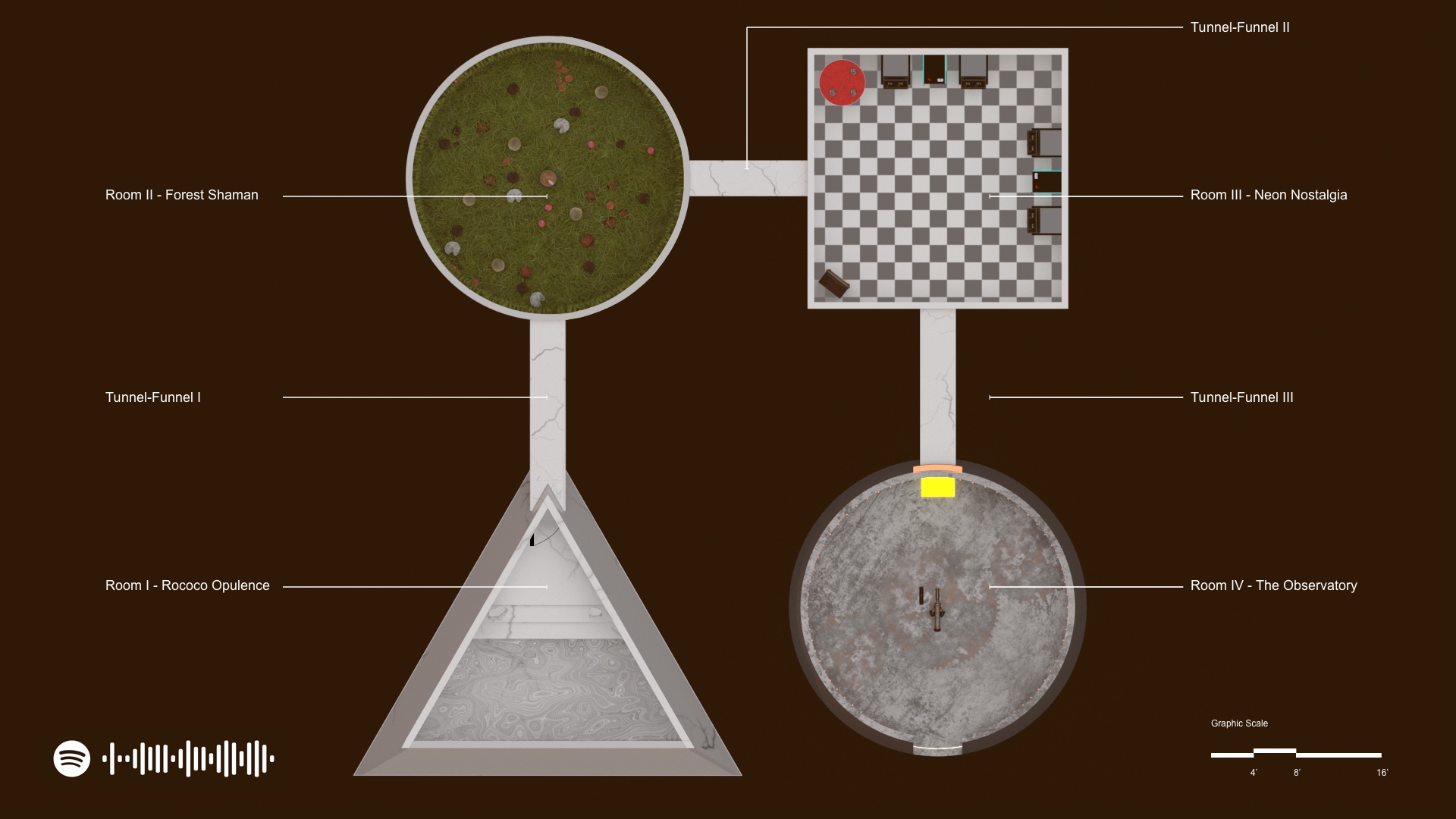
Above, Image 3

Above, Image 4
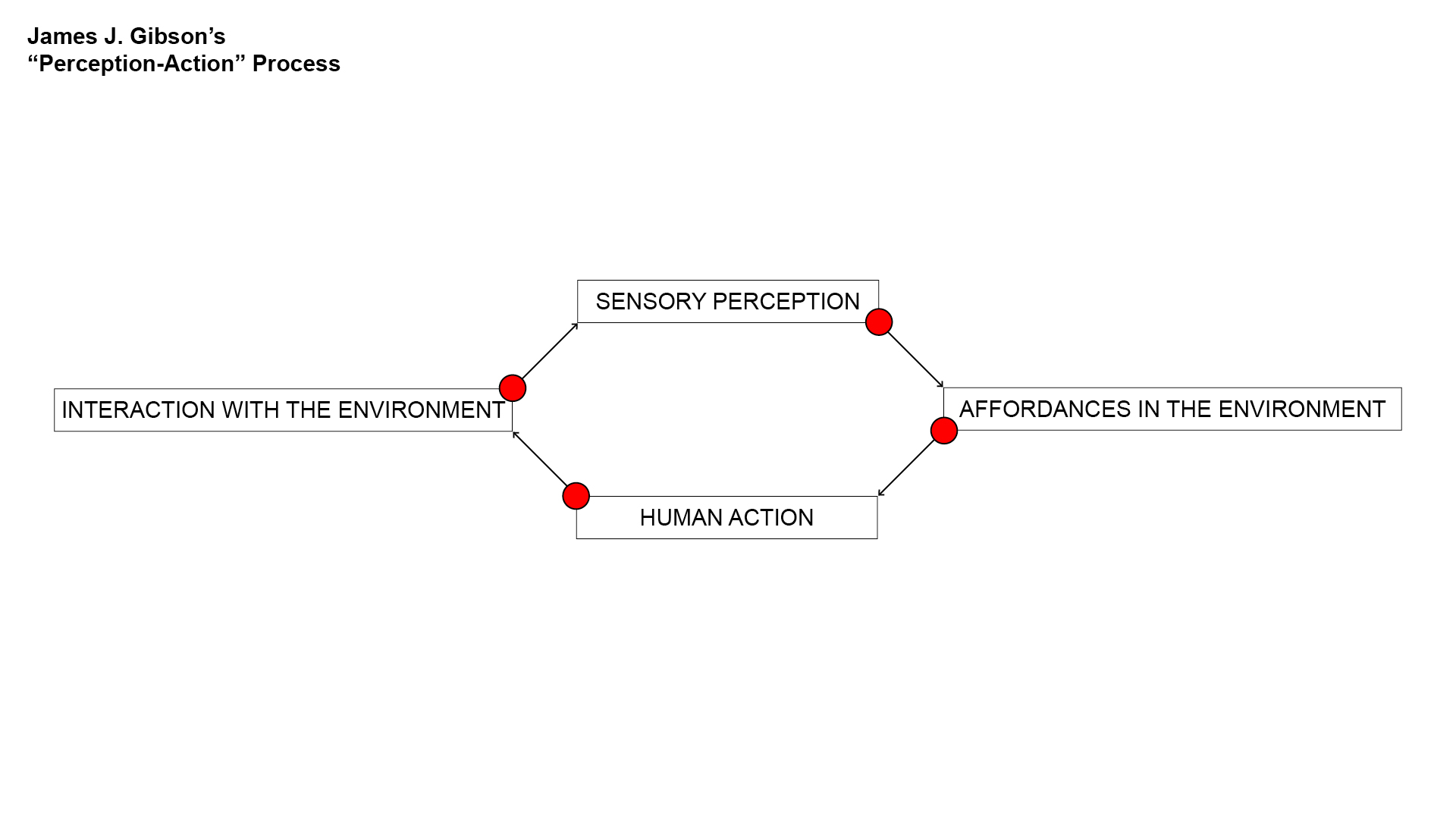
Above, Image 5
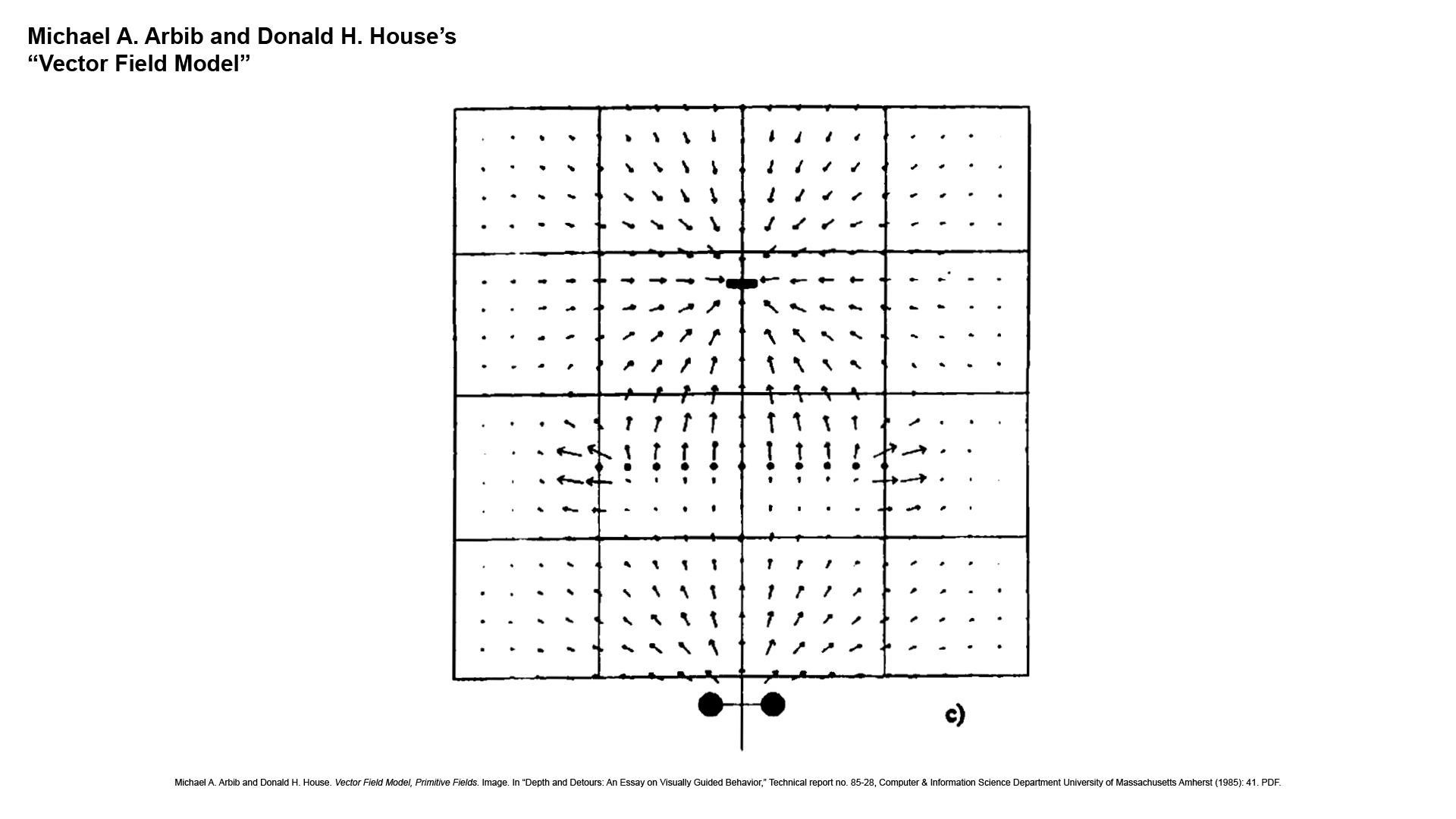
Above, Image 6
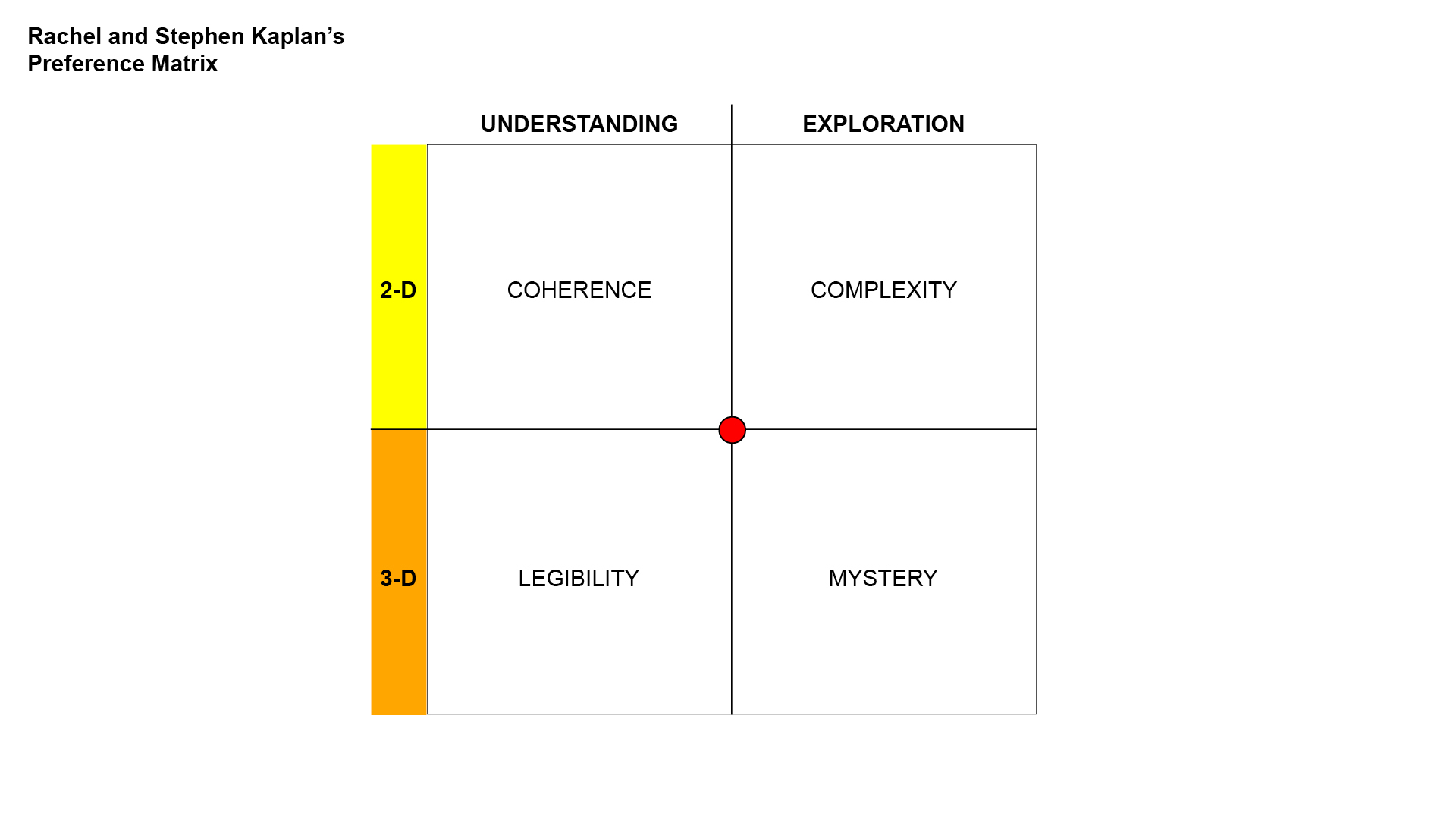
Above, Image 7
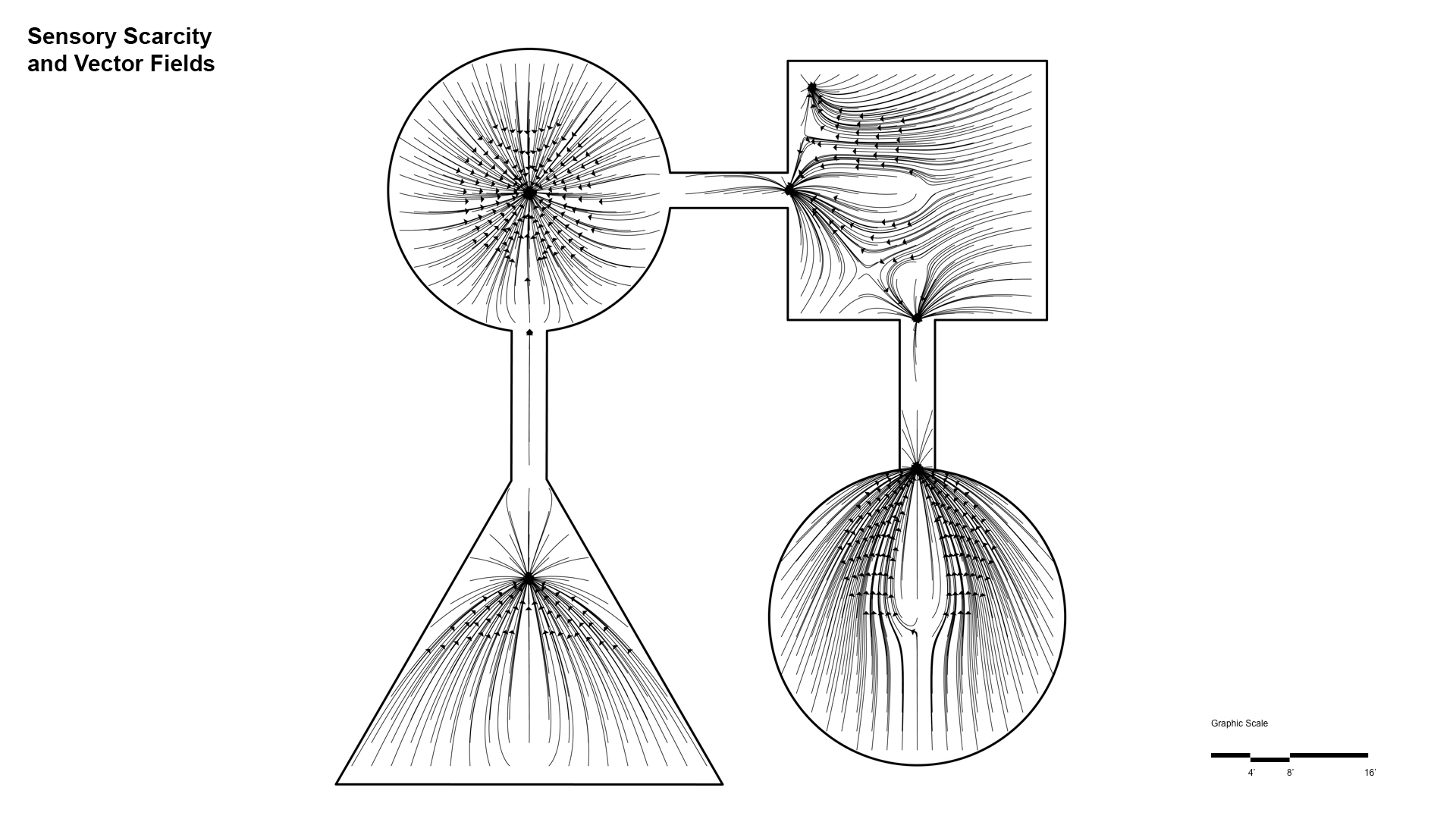
Above, Image 8
Image 1: Abraham Maslow’s model identifies a progression of human-centric needs. Satisfying a grouping of needs leads to another tier or level of needs (there are three levels in this model variant). Completing all levels of needs may yield feelings of fulfillment in human beings and emotionally resonant experiences. Multisensory spaces might boost feelings of intimacy and comfort and could help people satisfy lower-level needs. Additionally, multisensory spaces could enhance perception and in turn creativity—allowing people to satisfy mid-tier needs. Space engaging multiple senses could encourage people to focus their attention outward, instead of inward, to achieve “self-actualization”.
Image 2: Similar to Maslow’s model, Manfred Max-Neef’s model aims to explain the needs that are integral to humans; with nine categories of needs and ‘four states of living’ defined. While multisensory spaces can help fulfill the nine identified needs, multisensory spaces are capable of affecting three of the four states. “Being” is tied to the metaphorical and abstract qualities of existence. Therefore, spaces that engage five (or more) senses have a greater chance of connecting with non-concrete needs. “Doing” describes human actions. Because carrying out an action often requires sight and touch, multisensory spaces could help facilitate human action and achievement. “Interacting” is the space or stage for living. Underdeveloped spaces can stifle and squelch human fulfillment. However, multisensory spaces have the opportunity to provide occupants with environments that inspire, empower, comfort, and nudge people into new social relationships.
Image 3: Scan the Spotify code (or click here) to listen to the chanting and to increase immersion in the spatial experience.
- ‘Room I – Rococo Opulence’ engages sight, touch, hearing, and temperature. The brightly lit, chilly room is covered in faux marble. Test subjects walk through a thin layer of water to reach the stairs.i The harmonies of two, nude chanters echo throughout the room. Before the subject proceeds to the next space they must turn the handle on the tunnel door.
The dim and humid ‘Tunnel-Funnel I’ engages sight, touch, temperature, and proprioception. Test subjects are startled from the shift from brightness to darkness (and back again). As subjects crawl through the tunnel they touch the faux marble of the tunnel floor. - ‘Room II – Forest Shaman’ engages sight, smell, touch, taste, hearing, temperature, and proprioception. Proprioception occurs when the subject leaves the “compression” of the Tunnel-Funnel I and enters into the openness of this second room. It also occurs when subjects attempt to avoid crushing the mushrooms on the floor—tapping into balance. The hot, tropical space smells of roses. Subjects ‘taste’ when they are encouraged to eat the psychedelic mushroom.ii All the while, subjects can hear the chants of the two performers.
‘Tunnel-Funnel II’ like the first engages sight, touch, temperature, and proprioception (see above). - ‘Room III – Neon Nostalgia’ engages sight, smell, touch, taste, hearing, temperature, and proprioception. Proprioception occurs when the subject leaves the compression of the Tunnel-Funnel II and enters into the openness of this third room. The cool space provides relief from the hotness of the previous room and smells of sugar. Subjects can play on the whirring arcade machines and eat a chocolate-vanilla sundae. The psychedelic mushrooms may have affected the subject’s vision and balance, leading to a new spatial experience. The sound of the chanters is now becoming quite faint.
Tunnel-Funnel III’ like the first and second engages sight, touch, temperature, and proprioception (see above). - ‘Room IV – The Observatory’ engages sight, touch, hearing, temperature, and proprioception. Proprioception occurs when the subject leaves the compression of the Tunnel-Funnel III and enters into the openness of this fourth room. The subject enters the fourth room after pressing on a yellow glowing cube, which causes it to fall out on the other side (into a resting spot in the floor plate). This warm room has an operable telescope that allows subjects to view the moon and stars (while experiencing the psychedelic effects of the mushroom). The room is silent, which provides a sharp contrast to the prior rooms.
Image 4: Gazer cameras are installed in each room, which allow observers to accurately record the behavior of test subjects in the Tunnel-Funnels and the various rooms. The hope is that architects and scientists can unite over their research findings and create spaces that are consistently profound. As test subjects move between the rooms, via the Tunnel-Funnels they are squeezed and may experience feelings associated with claustrophobia. Scan the Spotify code (or click here) to listen to the chanting and to increase immersion in the spatial experience.
Image 5: James J. Gibson’s cyclical model posits that the sensory perception of humans allows them to pick up on advantageous things in the environment (also known as “affordances”). The process of getting to an affordance and using it requires human action. Through their actions, humans can interact with the environment and affect it. Their positive and negative effects on the environment can be perceived via the senses, thus restarting the cycle.
Image 6: This model indicates how “affordances” and obstacles in the environment can either attract or repel animals. This can be seen in Room I – Rococo Opulence and is very much dependent on cultural upbringing. The end goal is to get to the tunnel entrance and the flora in Room II – Forest Shaman. However, two nude chanters act as ‘an obstacle’. By successfully getting past the nude male and female the subject feels a greater sense of relief and the impact of the following room may be increased.
Image 7: This matrix investigates what makes a space or landscape captivating to humans. In this case, there needs to be a balance of legibility and mystery in order to draw people in. If the space is too mysterious and illegible humans cannot navigate easily and the experience becomes unsafe, frustrating, and uncomfortable. By giving subjects subtle multisensory and spatial cues observers can better ensure that subjects explore each room and stay enraptured in the various spaces.
Image 8: As test subjects progress through the spaces they experience contrasting sensory qualities that mutually enhance each other. By withholding sensory relief (i.e. so that subjects crave warmth) the laboratory designers can create moments with a great sensory payoff. In these moments the test subjects would hopefully return to a comfortable state and experience a revelatory moment. This diagram shows the vector field lines of attraction and repulsion at various points along the sensory journey. The dark regions are positively charged locations that are dense with vector arrowheads.
[1] "What is the WHO definition of health?," World Health Organization, accessed February 8, 2021, https://www.who.int/about/who-we-are/frequently-asked-questions.
[2] Saul McLeod, "Maslow's Hierarchy of Needs," Simply Psychology, last modified May 21, 2018, https://canadacollege.edu/dreamers/docs/Maslows-Hierarchy-of-Needs.pdf, 11.; The Editors of Encyclopaedia Britannica, “Humanistic psychology,” Encyclopædia Britannica, last modified May 27, 2020.
[3] Tony Greicius, "In the Zone: How Scientists Search for Habitable Planets," National Aeronautics and Space Administration, last modified August 7, 2017.
[4] Juhani Pallasmaa, The Eyes of the Skin Architecture and the Senses. (Chichester, West Sussex: Wiley, 2012), 11.; Francis D.K. Ching, Architecture: Form, Space, and Order (Hoboken: John Wiley & Sons, 2007), X.
[5] Juhani Pallasmaa, The Eyes of the Skin Architecture, 19.
[6] McLeod, "Maslow's Hierarchy,” 4.; Paul Ekins and Manfredi Max-Neef, Real Life Economics: Understanding Wealth Creation. (London, UK: Routledge, 1992), 199-200.; Manfredi A. Max-Neef, Antonio Elizalde, and Martín Hopenhayn, Human Scale Development: Conception, Application and Further Reflections. (London: Zed Books, 1991), 14-18.
[7] Juhani Pallasmaa, The Eyes of the Skin Architecture and the Senses. (Chichester, West Sussex: Wiley, 2012), 70.
[8] Dung Ngo, Tom Kundig: Houses. (Hudson: Princeton Architectural Press, 2006), 51.; Kwang-ho Kim, "A Study on the Concept of Prospect in Frank Lloyd Wright's Works," Journal of Asian Architecture and Building Engineering 1, no. 1 (March 2002): 299-300.; John C., Tuthill and Eiman Azim, "Proprioception," Current Biology 28, no. 5 (March 2018): R194.
[9] David W. Galenson, "Innovators: Architects," National Bureau of Economic Research Working Paper Series, (January 2010): 14.; Juhani Pallasmaa, The Thinking Hand: Existential and Embodied Wisdom in Architecture (Hoboken: Wiley, 2015), 15-16.
[10] "Arbib 3 Atmosphere as a Kind of Affordance," YouTube video, 1:07:06, posted by “Michael Arbib,” February 6, 2018,
[11] Pallasmaa, The Eyes of the Skin Architecture,19.
[12] Samin Nosrat, Salt, Fat, Acid, Heat: Mastering the Elements of Good Cooking. (New York: Simon & Schuster, 2017), 41-42, Apple Books.; Nosrat, Salt, Fat, Acid, Heat: Mastering, 91-92, Apple Books.; Nosrat, Salt, Fat, Acid, Heat: Mastering, 147, Apple Books.; Nosrat, Salt, Fat, Acid, Heat: Mastering, 181-182, Apple Books.
[13] Darren Bagley, “Beyond the five senses: Temperature,” Michigan State University, last modified November 19, 2015.; Jones, “Proprioception,” ScienceDirect, last modified 2000. Ching, Architecture: Form, Space, and Order, XI.; "Contrast Effect Definition," American Psychological Association, accessed February 10, 2021, https://dictionary.apa.org/contrast-effect.
[14] "Contrast Effect Definition," American Psychological Association.
[15] James J. Gibson, The Ecological Approach to Visual Perception. (Hove, East Sussex: Psychology Press, 2015), 119-120.
[16] Gibson, The Ecological Approach, 215-216.; Brett Martensen, "The Perception–Action Hierarchy and its Implementation Using Binons (Binary Neurons)," Procedia Computer Science 169 (2020): 489-490.; Ekins and Max-Neef, Real Life Economics: Understanding Wealth Creation, 201.; Max-Neef, Elizalde, and Hopenhayn, Human Scale Development: Conception, Application and Further Reflections, 23.; Michael A. Arbib and Donald H. House, “Depth and Detours: An Essay on Visually Guided Behavior,” Technical report no. 85-28, Computer & Information Science Department University of Massachusetts Amherst (1985): 40.;"Arbib 1 An Action Oriented Perspective on Space NfA@UCSD Winter2018 2018 01 10," YouTube video, 2:09:44, posted by “Michael Arbib,” January 10, 2018, ; Rachel Kaplan, Stephen Kaplan, and Robert L. Ryan, With People in Mind: Design and Management of Everyday Nature. (Washington, DC: Island Press, 2005), 13.
[17] Giovanni Petri et al., “Homological Scaffolds of Brain Functional Networks,” Journal of the Royal Society Interface
American Psychological Association. "Contrast Effect Definition." APA Dictionary of Psychology. Accessed February 10, 2021. https://dictionary.apa.org/contrast-effect.
Arbib, Michael. "Arbib 1 An Action Oriented Perspective on Space NfA@UCSD Winter2018 2018 01 10." Lecture presented at University of California San Diego, 2018. Video. YouTube. Posted by Michael Arbib, January 10, 2018. Accessed February 9, 2021.
———. "Arbib 3 Atmosphere as a Kind of Affordance." Lecture presented at University of California San Diego, 2018. Video. YouTube. February 6, 2018. Accessed February 9, 2021.
Arbib, Michael A., and Donald H. House. Depth and Detours: An Essay on Visually Guided Behavior. Technical report no. 85-28. Amherst, MA: Computer & Information Science Department University of Massachusetts Amherst, 1985. https://web.cs.umass.edu/publication/docs/1985/UM-CS-1985-028.pdf.
Bagley, Darren. "Beyond the five senses: Temperature." Michigan State University. Last modified November 19, 2015. Accessed February 16, 2021. https://www.canr.msu.edu/news/beyond_the_five_senses_temperature.
Britannica, T. Editors of Encyclopaedia (2020, May 27). Humanistic psychology. Encyclopedia Britannica. https://www.britannica.com/science/humanistic-psychology.
Ekins, Paul, and Manfredi Max-Neef. "Development and human needs." In Real Life Economics: Understanding Wealth Creation. 197-213. London, UK: Routledge, 1992.
Ching, Francis D. K. "Introduction." Introduction to Architecture: Form, Space, and Order, 3rd ed., X-XIV. Hoboken, N. J.: John Wiley & Sons, 2007.
Galenson, David W. "Innovators: Architects." National Bureau of Economic Research Working Paper Series, January 2010. National Bureau of Economic Research.
Gibson, James Jerome. The Ecological Approach to Visual Perception. Classic ed. Hove, East Sussex, UK: Psychology Press, 2015.
Greicius, Tony, ed. "In the Zone: How Scientists Search for Habitable Planets." National Aeronautics and Space Administration. Accessed February 8, 2021. https://www.nasa.gov/mission_p... kepler/news/kepler20130717.html.
Jones. "Proprioception." ScienceDirect. Last modified 2000. Accessed February 15, 2021. https://www.sciencedirect.com/topics/neuroscience/proprioception#:~:text=Proprioception%20(or%20kinesthesia)%20is%20the,force%20(Jones%2C%202000).
Kaplan, Rachel, Stephen Kaplan, and Robert L. Ryan. With People in Mind: Design and Management of Everyday Nature. Washington, DC: Island Press, 2005.
Kim, Kwang-ho. "A Study on the Concept of Prospect in Frank Lloyd Wright's Works." Journal of Asian Architecture and Building Engineering 1, no. 1 (March 2002): 297-301. https://doi.org/10.3130/jaabe.1.297.
Martensen, Brett. "The Perception–Action Hierarchy and its Implementation Using Binons (Binary Neurons)." Procedia Computer Science 169 (2020): 489-500.
Max-Neef, Manfredi A. Human Scale Development: Conception, Application and Further Reflections, by Manfredi A. Max-Neef, Antonio Elizalde, and Martín Hopenhayn. London, UK: Zed Books, 1991.
McLeod, Saul. "Maslow's Hierarchy of Needs." Simply Psychology. Last modified May 21, 2018. Accessed February 9, 2021. https://canadacollege.edu/dreamers/docs/Maslows-Hierarchy-of-Needs.pdf.
Ngo, Dung. "In the Realm of the Senses." In Tom Kundig: Houses, by Steven Holl, Rick Joy, and Billie Tsien, 47-53. Hudson, NY: Princeton Architectural Press, 2006.
Nosrat, Samin. Salt, Fat, Acid, Heat: Mastering the Elements of Good Cooking. 4th ed. Illustrated by Wendy MacNaughton. New York, NY: Simon & Schuster, 2017. Digital file.
Pallasmaa, Juhani. "Embodied Experience and Sensory Thought." Introduction to The Thinking Hand: Existential and Embodied Wisdom in Architecture, 11-23. Hoboken, NJ: Wiley, 2015.
———. The Eyes of the Skin Architecture and the Senses. Chichester, West Sussex, UK: Wiley, 2012.
Petri, Giovanni., Paul Expert, Federico Turkheimer, Robin Carhart-Harris, David Nutt, Peter J. Hellyer, and Francesco Vaccarino. "Homological Scaffolds of Brain Functional Networks." Journal of the Royal Society Interface 11, no. 101 (December 6, 2014): 20140873. https://doi.org/10.1098/rsif.2014.0873.
Tuthill, John C., and Eiman Azim. "Proprioception." Current Biology 28, no. 5 (March 2018): R194-R203. https://doi.org/10.1016/j.cub.2018.01.064.
"What is the WHO definition of health?" World Health Organization. Accessed February 8, 2021. https://www.who.int/about/who-we-are/frequently-asked-questions. 11, no. 101 (December 2014): 7.
Arbib, Michael A., and Donald H. House. Vector Field Model, Primitive Fields. Image. In Depth and Detours: An Essay on Visually Guided Behavior. Technical report no. 85-28. Amherst, MA: Computer & Information Science Department University of Massachusetts Amherst, 1985. PDF.
ARIA. Jukebox. 3D Model. Sketchfab. 2020. Accessed February 15, 2021. https://sketchfab.com/3d-models/jukebox-127cd1a00ca143af9db9cf4e58ddd956.
This 3D model has been re-textured and the glass panel has been removed
Borovkov, Nikita. Arcade Machine. 3D Model. Sketchfab. 2017. Accessed February 14, 2021. https://sketchfab.com/3d-models/arcade-machine-444b485039474d818aa661ca13ff4dff.
Bridge, Justin. "Om Mantra Meditation: Chanting Monks, Tibetan Singing Bowls." On Om Mantra Meditation: Chanting Monks, Tibetan Singing Bowls. By Justin Bridge. Great Meditation, 2015, compact disc. Accessed February 15, 2021. https://open.spotify.com/track/0CyFxPpaJz26JEAvWINs4l.
Britannica, T. Editors of Encyclopaedia (2020, May 27). Humanistic psychology. Encyclopedia Britannica.
https://www.britannica.com/science/humanistic-psychology.
Ekins, Paul, and Manfredi Max-Neef. "Development and human needs." In Real Life Economics: Understanding Wealth Creation. 197-213. London, UK: Routledge, 1992.
Gibson, James Jerome. The Ecological Approach to Visual Perception. Classic ed. Hove, East Sussex, UK: Psychology Press, 2015.
Ion_omat. Arcade machine. 3D Model. Sketchfab. 2017. Accessed February 13, 2021. https://sketchfab.com/3d-models/arcade-machine-aeaadc92e09842078d464d619ff5864a.
The arcade tickets have been removed from this model
JevinJones. Amanita muscaria mushroom. 3D Model. Sketchfab. 2020. Accessed February 14, 2021. https://sketchfab.com/3d-models/amanita-muscaria-mushroom-fc4ad155dc954025886425388f714135.
Johndesmond144. Telescope. 3D Model. Sketchfab. 2019. Accessed February 14, 2021. https://sketchfab.com/3d-models/telescope-f35899eb33d44b6983fc4f73ae4ce1ea.
This 3D model has been re-textured
Kaplan, Rachel, Stephen Kaplan, and Robert L. Ryan. With People in Mind: Design and Management of Everyday Nature. Washington, DC: Island Press, 2005.
Kim, Kwang-ho. "A Study on the Concept of Prospect in Frank Lloyd Wright's Works." Journal of Asian Architecture and Building Engineering 1, no. 1 (March 2002): 297-301. https://doi.org/10.3130/jaabe.1.297.
Martensen, Brett. "The Perception–Action Hierarchy and its Implementation Using Binons (Binary Neurons)." Procedia Computer Science 169 (2020): 489-500.
Max-Neef, Manfredi A. Human Scale Development: Conception, Application and Further Reflections, by Manfredi A. Max-Neef, Antonio Elizalde, and Martín Hopenhayn. London, UK: Zed Books, 1991.
McLeod, Saul. "Maslow's Hierarchy of Needs." Simply Psychology. Last modified May 21, 2018. Accessed February 9, 2021. https://canadacollege.edu/dreamers/docs/Maslows-Hierarchy-of-Needs.pdf.
Norgeot, Loïc. Lowpoly Mushrooms. 3D Model. Sketchfab. 2018. Accessed February 14, 2021. https://sketchfab.com/3d-models/lowpoly-mushrooms-c865fb845bac42c7939da06d4617b7b1.
Olivier, Ben. Rose Scan. 3D Model. Sketchfab. 2018. Accessed February 13, 2021. https://sketchfab.com/3d-models/rose-scan-48bc8f9448184489807301064d5dd538.
Warkarma. Sundae - Sketchfab Low Poly Challenge: Desserts. 3D Model. Sketchfab. 2020. Accessed February 13, 2021. https://sketchfab.com/3d-models/sundae-sketchfab-low-poly-challenge-desserts-523838ecb26b404d948b393a3dcc439e.
The glass bowl, ice cream scoop, crunchy bits, and cherries have been re-textured
Maxwell Zaleski © 2021–2025